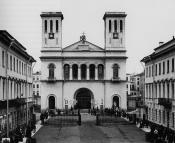
|
|
|
Entries
/
Civil Servants
Civil Servants
Categories /
Population/Professional Groups
CIVIL SERVANTS, a social-professional group forming a part of the St. Petersburg population, serving state institutions. In 1722 Emperor Peter the Great introduced a Table of Ranks, defining the hierarchy of officials (with the first rank being the highest and the 14th the lowest rank) and a regime for promotion. The lowest category of civil servant possessed consisted of individuals possessing no rank. In the 18th to the early 20th centuries in St. Petersburg they were responsible for all the highest organs for the management of the country: the Senate, Colleges (18th century), the Government Assembly, the ministries and main government (from the start of the 19th century). In 1869 civil servants consisted of more than 8,000 people in St. Petersburg. The state service was 76.5% - Russian, 8.4% - German, 7.5% Polish), in 1897 there were approximately 8,000 civil servants and more than 5,000 office administrators for legal and surveying department (there is no information concerning other departments). After October 1917 civil servants started working for the Soviet State. With the transfer of government to Moscow (March 1918) only local governmental organs remained. Since the 1990s there has been a growth in the number of civil servants for federal ministries: in 2001, 7,000 city civil servants were working and 11,000 servants of the federal government. References: Юхнева Н. В. Этнический состав и этносоциальная структура населения Петербурга, вторая половина XIX - нач. XX в.: Стат. анализ. Л., 1984. С. 56-65; Шепелев Л. Е. Чиновный мир России, XVIII - начало XX в. СПб., 1999. A. Y. Chistyakov.
Persons
Peter I, Emperor
Bibliographies
Юхнева Н. В. Этнический состав и этносоциальная структура населения Петербурга, вторая половина XIX - нач. XX в.: Стат. анализ. Л., 1984
Шепелев Л. Е. Чиновный мир России, XVIII - начала XX в. СПб., 1999
The subject Index
Senate
Collegiums (entry)
State Assembly
Russians
Germans
Poles
hidden
|
Armenians
ARMENIANS, an ethnic community forming a part of the St. Petersburg population. The Armenian language belongs to the Armenian group of Indo-European language family. Believers are mainly Christians (Monofisits)
|
|
|
|
|
hidden
|
Germans
GERMANS, an ethnic community forming a part of the St. Petersburg population. German language is related to the Germanic group of Indo-European languages. Their religion is Lutheran (amongst the St. Petersburg population up to 90%) and Catholic
|
|
|
|
|
hidden
|
Nobles
NOBLES, a social group within the St. Petersburg population. Nobility was a strict class that was divided by inheritance, and those who had received their title by merit for service (without the right to pass on their title through inheritance)
|
|
|
|
|
hidden
|
Poles
POLES, an ethnic community forming a part of the St. Petersburg population. The Polish language is related to the Slavic group of Indo-European languages. Their faith is Catholic. The Polish community in St
|
|
|
|
|
hidden
|
Population (entry)
POPULATION of St. Petersburg is the second largest in the Russian Federation after Moscow. From the 18th to the start of the 20th centuries the population continually grew: in 1725 - 40,000 people, in 1750 - 74,000; in 1800 - 220,000; in 1818 - 386
|
|
|
|
|
|














